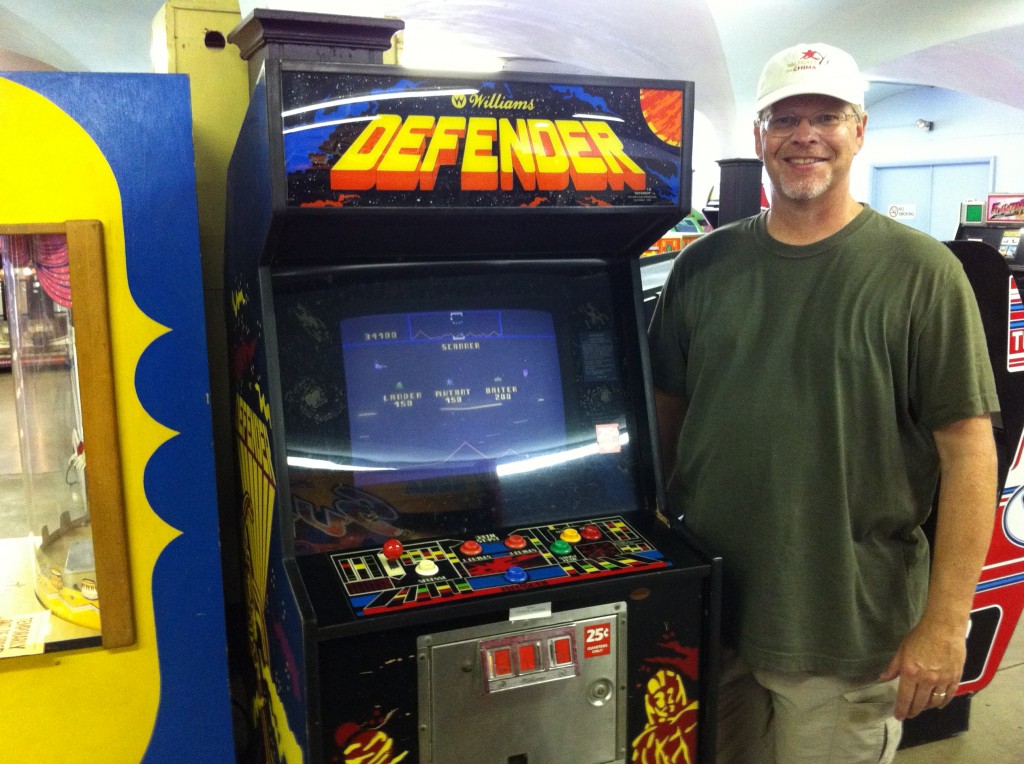
How does encountering the physicality of IP “things” change your sense of what’s right and what’s wrong with (or what works and what doesn’t) about IP systems?
Lots of us bring IP “toys” into the classroom: we have songs and videos to play, books to hand around and read from, plush toys, and squirt guns. Years ago, when I taught Larami Corp. v. Amron, I would bring a pair of Super Soaker-style guns to class – loaded. Unprepared students got wet.
Is there more than entertainment at work? Do we appreciate intangible IP stuff differently when we experience it in embodied form? I suspect that we do, and I suspect that there are both psychological and economic forces at work.
I was reminded of this the other day when I was wandering through the arcade at the Cedar Point Amusement Park in Sandusky, Ohio. I’m a roller coaster person, and for me visiting the park was the experience of a lifetime. But my son (also a coaster person) insisted on exploring the games arcade, and there, in the back, with a bunch of old pinball machines, was a collection of original videogames. Voila: Defender (pictured above), which in IP terms is the foundation for a great old case, Williams Electronics v. Artic International.
As an opinion, Williams is an odd and dry case. The legal question is whether the videogame is “fixed in a tangible medium of expression” so that Williams can pursue a copyright infringement case against a competitor (Artic) that produced a knockoff. This is a no-brainer today but was a somewhat difficult question thirty years ago, when the case was decided. Like a lot of teachers, I use the case mostly to talk about the different sources and meanings of the fixation concept, particularly with respect to the “Attract Mode” portion of the case. The plaintiff pursued claims regarding audio-visual copyrights in the “Attract Mode,” which plays on the screen when no one is playing the game, as well as in the “Play Mode,” which is what the player interacts with. (In addition to shooting the photo above, I also used my handy iPhone to record a complete 60-second cycle of the Attract Mode, and I would be happy to share a copy of that really mediocre video (shot in a videogame arcade!) with any teacher who would like a copy.)
What struck me the other day, however, was that my reaction to the console — the physical box containing the game — was quite different than my reaction to the copyright case on the printed page. Defender is self-evidently “fixed” in a “tangible medium” in a way that cannot be lost on anyone standing in front of the thing. How could this original / creative thing not be copyrightable?
That’s my anecdotal psychology. Here’s my anecdotal economics:
After I got home, I looked up the copyright registration for the game and learned that Williams registered not only a copyright in the game but also a copyright in the artwork that decorated the game cabinet. One way to look at that is to assume that Williams’ lawyers took a belt-and-suspenders approach to their IP strategy: They filed for copyright protection on everything that they could imagine would be eligible for copyright protection. A distinct but not inconsistent way to look at that is to assume that Williams thought of the electronics + console + decoration + name as its “product,” the thing that drove considerations regarding investment and recoupment. Parsing those things into different IP categories and different copyright categories was an after-the-fact formalization dictated by the structure of the law.
That slightly different framing doesn’t change the outcome of the case, I think. But it does make me think a bit differently about the nature of and need for IP protection. I wrote a bit more along these lines in a short paper a couple of years ago titled “Of Coase and Comics,” a comment on Otiar and Sprigman’s “There’s No Free Laugh (Anymore)” (trying to explain the non-enforcement of formal IP rules among stand-up comics). One of my points was (and is) that the market for stand-up comedy, particularly in the era that most concerned Otiar and Sprigman, can’t and shouldn’t be separated (in economic terms) from the market for comedy albums.
Mike — Arctic Int’l is one of my favorite cases to write and talk about. I tell my students sometimes that since Williams came prior to Apple v. Franklin in the 3d Circuit and crossed the threshold into copyright protection for software, one could argue that if it were not for Defender, there might have never been a Microsoft.
Comments are closed.